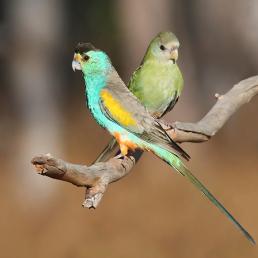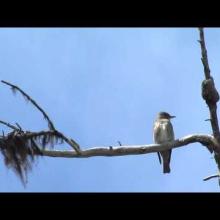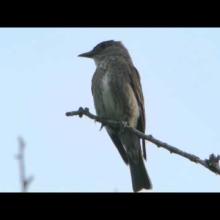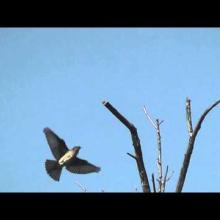

Join BirdNote tomorrow, November 30th!
Illustrator David Sibley and actor H. Jon Benjamin will face off in the bird illustration battle of the century during BirdNote's Year-end Celebration and Auction!
The vast Canadian boreal forest provides breeding habitat for almost half of North America's migratory ducks, geese, and songbirds - including this Olive-sided Flycatcher. But the boreal forest is under increasing pressure from logging, mining, the development of petroleum, infestations of pine beetles, and climate change. However, Indigenous Nations are protecting boreal forest lands on a sweeping scale. In 2019, the Lutsel K’e Dene First Nation worked with the Canadian government to create one of the biggest protected areas in the country. The Sahtu Dene are planning to conserve an area 12 times the size of Yellowstone. And the Sayisi Dene want to preserve over 12 million acres—habitat for millions of nesting landbirds and tens of thousands of migrating waterfowl.
BirdNote®
Conserving Canada’s Boreal Forests
Adapted from a script by Todd Peterson
This is BirdNote.
[Songs and calls of birds that breed in Canada’s boreal forest]
The vast Canadian boreal forest provides breeding habitat for up to three billion of North America’s migratory ducks, geese, and songbirds. Add the young raised over the summer, and there may be as many as five billion birds.
[Croaking and “conversation” of ravens]
The boreal forest is “one of the largest intact forest and wetland ecosystems remaining on earth.” But the boreal is under increasing pressure from logging, mining, the development of petroleum, infestations of pine beetles, and climate change. [Call of Boreal Chickadee]
However, Indigenous Nations are protecting boreal forest lands on a sweeping scale. In 2019, the Lutsel K’e Dene First Nation worked with the Canadian government to create one of the biggest protected areas in the country. The Sahtu Dene are planning to conserve an area 12 times the size of Yellowstone. And the Sayisi Dene want to preserve over 12 million acres—habitat for millions of nesting landbirds and tens of thousands of migrating waterfowl.
The biggest, most ambitious proposals for conserving lands in Canada are coming from Indigenous Nations. And these lands offer hundreds of bird species the best chance to adapt and thrive into the future.
For BirdNote, I’m Michael Stein.
###
Thanks to Emily Cousins at BorealBirds.org and to Jeff Wells at Audubon for their assistance.
Bird sounds provided by The Macaulay Library of Natural Sounds at the Cornell Lab of Ornithology, Ithaca, New York. Sound track of the boreal forest recorded by G.F. Budney. Calls of Ravens and Sandhill Cranes were recorded by G.A. Keller; Boreal Chickadee by G. Vyn.
Producer: John Kessler
Executive Producer: Sallie Bodie
Editor: Ashley Ahearn
Associate Producer: Ellen Blackstone
Assistant Producer: Mark Bramhill
BirdNote’s theme was composed and played by Nancy Rumbel and John Kessler.
© 2020 BirdNote February 2020
ID# SotB-boreal-01-2011-02-01 SotB-boreal-01b Narrator: Michael Stein
https://www.borealbirds.org/announcements/1500-scientists-worldwide-cal…
And scores of other Indigenous-led proposals will help preserve bird nesting grounds across the boreal.
Meanwhile, outside of protected areas, many Indigenous Nations and their partners are urging businesses to pursue projects that are more sustainable. The public has a role to play in encouraging forestry companies to meet higher standards in the boreal, too. The choices you make in what you buy – recycled paper, for example – do make a difference in the lives of birds.






